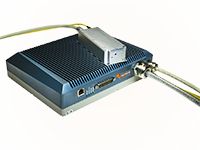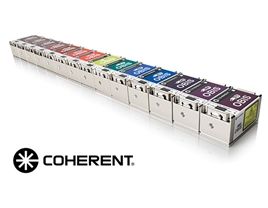yellow and orange lasers (original) (raw)
Definition: lasers emitting yellow or orange light
Category:  laser devices and laser physics
laser devices and laser physics
- lasers
- visible lasers
* red lasers
* yellow and orange lasers
* green lasers
* blue lasers
- visible lasers
Related: red lasersgreen lasersblue lasersvisible lasers
Page views in 12 months: 1100
DOI: 10.61835/9l3 Cite the article: BibTex BibLaTex plain textHTML Link to this page! LinkedIn
Content quality and neutrality are maintained according to our editorial policy.
📦 For purchasing yellow and orange lasers, use the RP Photonics Buyer's Guide — an expert-curated directory for finding all relevant suppliers, which also offers advanced purchasing assistance.
Introduction
This article discusses laser sources emitting in the yellow to orange spectral region, i.e. with a wavelength roughly around 570–625 nm. This spectral region is relatively difficult to access, at least when high output power, beam quality and power efficiency are required. Nevertheless, various types of yellow and orange laser sources exist:
- InGaP-based laser diodes may emit orange light e.g. around 610 nm [1]. The shorter the wavelength, the more difficult it is to obtain a good power efficiency and long lifetime.
- Praseodymium/ytterbium-doped upconversion lasers, e.g. based on fluoride fibers, can emit orange light with wavelengths around 605 nm [2].
- Dye lasers can cover the whole yellow–orange spectral region.
- helium–neon lasers can utilize an orange laser transitions at 612 nm and 594.1 nm.
- Copper vapor lasers can emit pulses of yellow light at 578 nm [5].
- There are various types of frequency-doubled lasers, where the actual laser emits in the 1.1–1.2-μm spectral region and a frequency doubler converts this radiation into orange or yellow light. For example, a Cr4+:MgSiO4 (forsterite) laser can cover this spectral range [3]. There are also optically pumped semiconductor lasers (VECSELs) based on GaInNAs or InGaAs quantum wells, which can generate orange or yellow light via intracavity frequency doubling [7, 8].
- Some yellow or orange laser sources are based on sum frequency generation. For example, mixing the outputs of two Nd:YVO4 lasers emitting at 1064 nm and 1342 nm, respectively, results in orange light with 593.5 nm. There are even laser pointers containing such a source, but these are fairly expensive.
- Optical parametric oscillators may emit orange or yellow light, when pumped with a blue laser.
- There are Raman lasers, often based on Raman-active bulk crystals (e.g. tungstate crystals), which can either generate orange or yellow light from green pump light [4], or generate light with wavelengths around 1.1–1.2 μm with a 1-μm pump source [6], so that subsequent frequency doubling or sum frequency generation leads to orange or yellow light.
Orange and yellow laser sources are applied e.g. for laser guide stars (sodium laser beacons) and in medical laser therapies (e.g. photocoagulation in ophthalmology). Orange or even yellow laser pointers exist but are not common.
Suppliers
Sponsored content: The RP Photonics Buyer's Guide contains 41 suppliers for yellow and orange lasers. Among them:
⚙ hardware
Latest developments in semiconductor amplifier and frequency-doubling technology expand the color and power spectrum of tunable diode lasers to more than 1000 mW at yellow and orange wavelengths. Applications such as laser cooling of sodium, dysprosium or erbium and spectroscopy of rare-earth ions in solids benefit from the compact and easy-to-handle laser systems. Lasers can be used also for a variety of applications to study objects ranging from nanometer scale, via micro- or macroscopic size, even towards galaxies and the universe. For example, artificial guide stars are required to optimize the spatial resolution of Earth-based telescopes. These artificial stars can be created using TOPTICA's guide star laser SodiumStar. This system has been decorated with the Berthold Leibinger innovation price for Laser Research in 2016.
⚙ hardware
Serving North America, RPMC Lasers offers a selection of yellow & orange output lasers, including pulsed DPSS, CW HeNe, and tunable pulsed types, with free-space or fiber-coupled output, ranging from OEM components to turnkey systems for various applications.
They deliver stable yellow wavelengths from 560–590 nm via matured DPSS tech, with options for power, energy, pulse width, and rep rate, ideal for fluorescence microscopy, DNA sequencing, and life sciences.
Optimized for scientific and industrial use, they offer excellent beam quality and stability for microscopy, spectroscopy, and sensitive fluorescence detection, with configurable platforms for easy integration.
Let RPMC help you find the right laser today!
⚙ hardware
The Lumibird CVFL-GIGA are frequency-converted ytterbium-doped fiber lasers emitting at a fixed design wavelength from 520 nm up to 590 nm.
⚙ hardware
CNI offers diode-pumped all-solid-state yellow and orange lasers with wavelengths from 577 nm to 604 nm. The output power is up to 25 W and the pulse energy up to 5 mJ. Single longitudinal mode, low noise, high stability, OEM versions are all available options.
⚙ hardware
VEXLUM offers VECSEL technology with intracavity frequency doubling, producing diffraction-limited, watt-level lasers across the yellow-orange spectral region (565–625 nm), which is very challenging for competing technologies. The lasers feature a wavelength tuning range of ±1 nm and a narrow linewidth, ideal for various applications:
Quantum technology:
- Yb clock (quadrupole, 578 nm / 2 W)
- Yb 2nd stage narrow cooling (555 nm / 2 W)
- Ba repumping (614 nm / 2 W)
Others:
- Sodium guide star laser at 589 nm
⚙ hardware
Edmund Optics offers yellow and orange lasers in the form of solid-state lasers from the Coherent OBIS™ series.
⚙ hardware
MPBC is a pioneer in providing fiber lasers in the yellow and orange region, opening up applications for yellow and red fluorescent dyes.
Our design flexibility is such that we can offer any wavelength in this region, with output powers from 200 mW to 5 W. The lasers are air-cooled, available in either an OEM compact package, or a 2RU rack-mountable package with integrated power supply and are shipped with a user-friendly graphical user interface for ease of set up and operation. MPBC also offers optional fiber coupling.
⚙ hardware
HÜBNER Photonics specializes in high-performance yellow and orange lasers, ideal for various applications requiring precise wavelength control. Our offerings include:
- Cobolt 04-01 Series
- Cobolt 05-01 Series
- Cobolt 06-01 Series
Available wavelengths:
For more details on our laser products and to find the perfect solution for your needs, please visit our product pages.
Bibliography
| [1] | C. J. Nuese et al., “Orange laser emission and bright electroluminescence from In1-xGaxP vapor-grown p–n junctions”, Appl. Phys. Lett. 20, 431 (1972); doi:10.1063/1.1654004 |
|---|---|
| [2] | P. Xie and T. R. Gosnell, “Room-temperature upconversion fiber laser tunable in the red, orange, green, and blue spectral regions”, Opt. Lett. 20 (9), 1014 (1995); doi:10.1364/OL.20.001014 |
| [3] | A. Sennaroglu, “Broadly tunable continuous-wave orange-red source based on intracavity-doubled Cr4+:forsterite laser”, Appl. Opt. 41 (21), 4356 (2002); doi:10.1364/AO.41.004356 |
| [4] | R. P. Mildren et al., “Efficient, all-solid-state, Raman laser in the yellow, orange and red”, Opt. Express 12 (5), 785 (2004); doi:10.1364/OPEX.12.000785 |
| [5] | E. Le Guyadec et al., “A large volume copper vapor +HCl–H2 laser with a high average power”, IEEE J. Quantum Electron. 41 (6), 879 (2005); doi:10.1109/JQE.2005.846686 |
| [6] | R. P. Mildren et al., “Discretely tunable, all-solid-state laser in the green, yellow and red”, Opt. Lett. 30 (12), 1500 (2005); doi:10.1364/OL.30.001500 |
| [7] | J. Rautiainen et al., “2.7 W tunable orange-red GaInNAs semiconductor disk laser”, Opt. Express 15 (26), 18345 (2007); doi:10.1364/OE.15.018345 |
| [8] | M. Fallahi et al., “5-W yellow laser by intracavity frequency doubling of high-power vertical-external-cavity surface-emitting laser”, IEEE Photon. Technol. Lett. 20 (20), 1700 (2008); doi:10.1109/LPT.2008.2003413 |
| [9] | Z. Liu et al., “Self-frequency-doubled KTiOAsO4 Raman laser emitting at 573 nm”, Opt. Lett. 34 (14), 2183 (2009); doi:10.1364/OL.34.002183 |
| [10] | H. Zhu et al., “Yellow-light generation of 5.7 W by intracavity doubling self-Raman laser of YVO4/Nd:YVO4 composite”, Opt. Lett. 34 (18), 2763 (2009); doi:10.1364/OL.34.002763 |
| [11] | L. R. Taylor et al., “50 W CW visible laser source at 589 nm obtained via frequency doubling of three coherently combined narrow-band Raman fibre amplifiers”, Opt. Express 18 (8), 8540 (2010); doi:10.1364/OE.18.008540 |
| [12] | Z. Cong et al., “Theoretical and experimental study on the Nd:YAG/BaWO4/KTP yellow laser generating 8.3 W output power”, Opt. Express 18 (12), 12111 (2010); doi:10.1364/OE.18.012111 |
| [13] | J. Rautiainen et al., “2.5 W orange power by frequency conversion from a dual-gain quantum-dot disk laser”, Opt. Lett. 35 (12), 1935 (2010); doi:10.1364/OL.35.001935 |
| [14] | D. Pabœuf et al., “Diode-pumped Pr:BaY2F8 continuous-wave orange laser”, Opt. Lett. 36 (2), 280 (2011); doi:10.1364/OL.36.000280 |
| [15] | E. Kantola et al., “High-efficiency 20 W yellow VECSEL”, Opt. Express 22 (6), 6372 (2014); doi:10.1364/OE.22.006372 |
| [16] | B. Ernstberger et al., “Robust remote-pumping sodium laser for advanced LIDAR and guide star applications”, Proc. SPIE, 9641, 96410F (2015); doi:10.1117/12.2194874 |
| [17] | R. Bege et al., “Watt-level second-harmonic generation at 589 nm with a PPMgO:LN ridge waveguide crystal pumped by a DBR tapered diode laser”, Opt. Lett. 41 (7), 1530 (2016); doi:10.1364/OL.41.001530 |
| [18] | M. Lord et al., “Monolithic silica fiber laser operating at 585 nm”, Opt. Lett. 48 (2), 514 (2023); doi:10.1364/OL.480592 |
| [19] | D. Mitten et al., “High output power, single mode, and TEM00 operation of a multiple gain chip VECSEL using a twisted-mode configuration”, Opt. Express 31 (8), 12680 (2023); doi:10.1364/OE.486113 |
| [20] | Yu Fu et al., “Intracavity frequency-doubled yellow laser in an electron–phonon-coupled Nd:YVO4 crystal”, Opt. Lett. 49 (3), 578 (2024); doi:10.1364/OL.515131 |
(Suggest additional literature!)
Questions and Comments from Users
Here you can submit questions and comments. As far as they get accepted by the author, they will appear above this paragraph together with the author’s answer. The author will decide on acceptance based on certain criteria. Essentially, the issue must be of sufficiently broad interest.
Please do not enter personal data here. (See also our privacy declaration.) If you wish to receive personal feedback or consultancy from the author, please contact him, e.g. via e-mail.
By submitting the information, you give your consent to the potential publication of your inputs on our website according to our rules. (If you later retract your consent, we will delete those inputs.) As your inputs are first reviewed by the author, they may be published with some delay.















